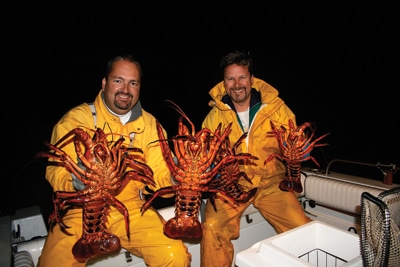
There’s a war out there, over bugs. More precisely, over California spiny lobsters. Today, the pursuit of these delectable, tail-snapping, rust-color crustaceans pits boater against boater in feuds that boil up at night.
This is recreational lobster fishing off the southern California coast. And if you thought West Coast boaters were laid back, dude, you haven’t been buggin’.
Far from mellow, a typical bug battle unfolds like this: Claim Jumper arrives around dusk at the captain’s favorite lobster spot but finds another boat, Vanguard, has already set its lobster nets. Undeterred, Claim Jumper begins setting nets 50 yards away from Vanguard’s string.
Vanguard’s captain bristles and bolts over to confront Claim Jumper. “You’re not seriously going to fish here?” he barks, chopping his throttle just in time to avert a collision. “We’ve already set our nets here, so you need to go somewhere else,” he shouts, the boats now practically gunwale to gunwale, the boating version of chest bumping.
Claim Jumper’s captain offers assurances that there are plenty of lobsters for both boats and that he won’t get in the way.
“You’re already in my way, and you need to get the **** out of here,” shouts the captain of Vanguard.
“Well, that’s not going to happen,” says Claim Jumper’s captain as he drives away and continues setting his nets.
Now spitting mad, Vanguard’s captain charges Claim Jumper, turning off at the last second. The intimidation tactic doesn’t work. “This is a bunch of sh*t,” he sputters before spinning his boat around and racing away in the dark.
In case you’re wondering, while the boat names were changed, this lobster tale is true. I was crew on Claim Jumper.
Nightly Drama
Drama similar to this plays out nightly during California’s six-month recreational spiny lobster season, which begins this year on Sept. 29 and ends on March 20, 2013. The start of the season sends frenzied boaters out in droves, each jockeying for the best fishing spots. The goal is to catch daily limits (seven per angler) of bugs.
California’s spiny lobster is similar to Florida’s spiny lobster in that it has no claws and dwells within structure most of the time. Once the sun starts sinking on the left coast, the bugs venture out in what locals call a crawl. This is the best time to catch them.
For many years prior, the recreational harvest was confined largely to divers — a hardy few with the skills and bravado to plunge into inky waters and wrestle critters in the dark. Yet within the past seven years, a more productive technique has gained immense popularity — hoop-netting at night. No more night dives. Just drop a baited net (see “Hoop-Netting Gear”), let it soak for 30 minutes, and then pull it up quickly to see if lobsters have crawled inside.
As more hoop-netters take to the water at night, competition for productive bottom structure has grown, leading to hot-tempered altercations (mostly verbal), particularly when one hoop-netter encroaches on another.
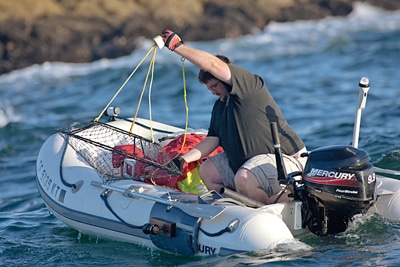
Divers vs. Hoop-Netters
Dust-ups aren’t confined to competing hoop-netters. Divers and hoop-netters also butt heads, as we witnessed on the second night of the 2011/12 season while photographing the melee outside the breakwater protecting the Marina del Rey harbor mouth.
More than a dozen hoop-netters were working the 700-yard-long wall in the early evening when a boat pulled in and dropped off a pair of scuba divers. The divers swam directly for the base of the breakwater where the hoop nets lay. VHF radio chatter grew intense and profane between the netters and the dive boat, and one net boat harassed the divers by following and hovering over the bubbles. No one was hurt, despite the menacing hoop-netter and threats to settle the matter back at the dock.
Curiously, divers don’t seem to mind hoop-netters. As one diver put it, “I love hoop-netters. They gather up the lobsters for me in nice baskets.” He was only half joking.
Hoop-netters, on the other hand, claim that divers do more than pluck lobsters from the nets. There are Internet accounts of retrieving slashed nets after divers have swum through an area.
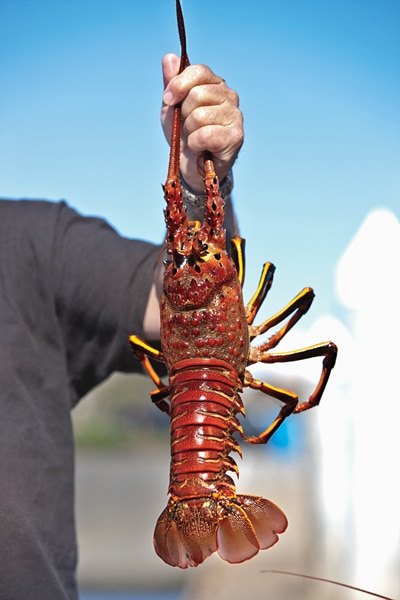
All of this over a crustacean, albeit one of the most spectacular of its kind. The California spiny lobster can grow to weights of 20 pounds, though most legal bugs are much smaller — usually around two pounds. Many say the tail meat is the sweetest and most succulent of all lobsters, though others say the meat of Maine lobster is more tender. Market prices for California spinys fluctuate but reach as high as $35 a pound for live lobster. On top of this, demand by Asian buyers is accelerating.
Supply is relatively low. The commercial harvest of California spiny lobster averages about 660,000 pounds annually, with the recreational harvest estimated between 198,000 and 396,000 pounds. This is a drop in the kettle compared with the 115-million-pound annual harvest of Atlantic lobster. It is the comparative dearth, delicious meat and high value of California spinys that send boaters into battle.
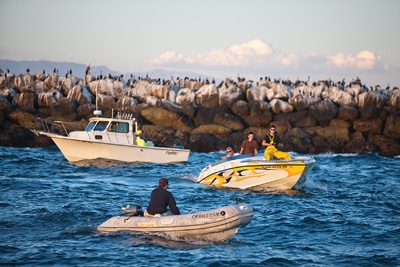
What to Look For
These bugs love nooks and crannies where they can clamber inside and hide. That’s why breakwaters and jetties of harbors such as Ventura, Channel Islands, Marina del Rey, Redondo, Long Beach, Dana Point and others are so productive.
Lobsters also dwell within kelp-covered rocks and reefs, as well as in the rotting hulks of wrecks that dot the southern California coast and offshore islands. Yet many kelp lines, rock piles and wrecks are already lined by commercial lobster traps. Commercial pressure significantly reduces the recreational catch rate on a given spot, and so the key is to look for areas where commercial fishing is prohibited or less prevalent.
That’s why breakwaters and jetties are popular; commercial lobster pots are largely prohibited close to these walls, because the lines and buoys pose navigational hazards. That leaves the lobsters to recreational guys. Plus breakwaters and jetties are easy to find.
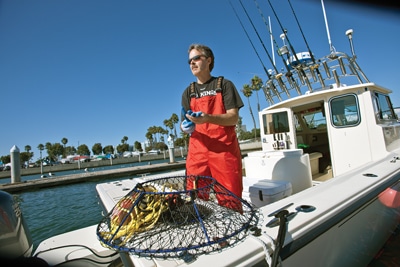
“Kelp lines are also easy to find,” said Capt. Mark Wisch, who has run hoop-netting charters out of Huntington Harbour, California, for the past few years. “The most productive kelp lines are on the lee side of Catalina Island and in Santa Monica Bay, particularly from Malibu Point to Rocky Point, where commercial lobster fishing is prohibited.”
The hoop nets, baited with oily fish such as mackerel, are set along the edges of rocks, reefs and kelp lines in the hope that the scent will entice lobsters to leave their sanctuaries and crawl into the net to feast.
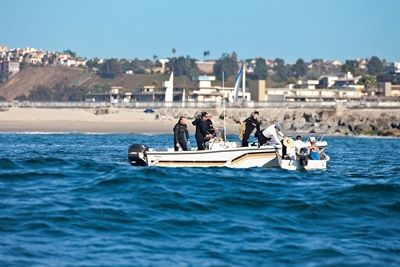
Unwritten Rules
Strict regulations are imposed on recreational lobster fishing by the California Department of Fish and Game (see “Lobster Regulations”), but there are also some unwritten rules for boaters. It is when these are broken that battles tend to ensue.
One of the most important unwritten rules is that first arrivals get their choice of spots, and so some hoop-netters arrive in the afternoon to set their nets (10 is maximum) and stake their claims. Late arrivals need to keep an acceptable distance or go elsewhere. Conflicts arise over what an acceptable distance is. Also, the definition of acceptable distance can vary, depending on the locale.
In the altercation between Vanguard and Claim Jumper, for example, 50 yards seemed like an acceptable distance to the captain of Claim Jumper, though the captain of Vanguard disagreed.
“Anything less than 50 yards is definitely encroachment, unless fishing an extremely popular spot such as the Marina del Rey breakwater,” said Steve Bowcott, who keeps his boat docked in Marina del Rey and fishes the breakwater regularly. “In this case, 20 to 25 yards is an acceptable distance. The main goal here is for a late-arriving boat to avoid setting his nets in a manner that might interfere with another boat trying to pick up its established set of nets.
“While fishing the breakwater, I’ve seen boats drop nets right on top of mine, and that’s totally uncool,” Bowcott said. “Just picking up my buoy becomes a major ordeal, especially in trying to keep from fouling my prop in his line.”
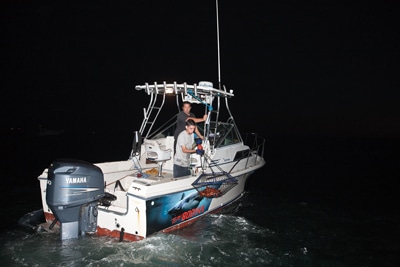
Safety First
Working lobster nets in the dark is one thing, but throw in big seas, wind and proximity to exposed rocks, and you have the makings of a potential catastrophe. So the first safety edict is to watch the weather and sea state, and the second is to stay well clear of dangerous rocks and shore breaks.
That’s pretty basic stuff, and you’d think it would be easy advice to follow. Yet the lure of Pacific treasure seems to constantly suck boaters into harm’s way, largely because lobster fishing really heats up when big seas stir the bottom near shore. This has led to the saying “When the waves are tall, the bugs will crawl.” It has also led to boats being tossed on the rocks or capsized while hoop-netting close to shore. Tragically, on more than one occasion, it has resulted in loss of life.
The cascade of events in such a disaster often includes a fouled propeller. The polypropylene line used for the hoop nets is the main culprit, and once wrapped in the prop, a boat can lose propulsion. For this reason, most hoop-netters prefer outboards and sterndrives, allowing them to tilt up the drive and quickly untangle or cut a fouled line. Also, safety-conscious hoop-netters always have the anchor ready to deploy should the boat lose power or steering for any reason.
Lobsters have a mysterious grip on southern California boating anglers, luring them out on the Pacific Ocean at night, loaded with nets, buoys and bait, ready to brave big seas and stand their ground against other fishermen. The California spiny lobster season is upon us. Let the bug battles begin.** **
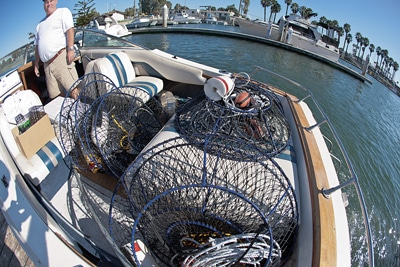
Hoop-Netting Gear
Hoop nets such as the Promar Ambush ($29.99, bajafishgear.com) have conical designs with a wide ring at the base and a slightly smaller ring above, supported by a series of stays.** **
Bait cages ($5.69, pacificedgetackle.com) tie-wrapped to the center of the net keep lobsters from stealing the bait. A small buoy floats the polypropylene harness above the net.
A main poly line connects the harness to a pot buoy. Obviously, you need to make sure there’s enough line to reach the bottom. Lobsters dwell in waters as shallow as a few feet to depths of 150 feet or more.
Also, hoop-netters often light their buoys by drilling each with a half-inch hole for pressing in a Cyalume glow stick. Numbering the buoys helps boaters keep track of which nets are producing the best. Most hoop-netters pull the nets by hand, but it’s legal to employ motorized winches. Other items that prove helpful include:
Gloves for hauling nets and handling lobsters.
Rain gear and rubber boots to fend off the water and bait slime.
Lobster measuring gauge (required by California regulations).
An LED headlight to spot buoys and provide hands-free illumination while measuring lobsters.
Lobster Regulations
California spiny lobster fishing is highly regulated. For a full rundown, visit the California Department of Fish and Game website (dfg.ca.gov/marine/invertebrate/lobster.asp). In the meantime, here are some of the basic regulations.
For an adult (16 years or older) to legally hoop-net for lobsters off southern California, the following is required:
–California state sport-fishing license with an ocean enhancement stamp ($49.99/year, dfg.ca.gov/licensing/ols).
–California state lobster report card ($9.21/year, dfg.ca.gov/licensing/ols).
–Measuring gauge ($4.95, amazon.com).
Other Key Regs:
–Maximum number of hoop nets per person is five, with a per-boat maximum of 10 (no matter how many are aboard).
–Minimum legal size is 3 1/4 inches lengthwise from the slot between the horns to the rear edge of the carapace.
–Maximum daily limit is seven legal lobsters per person.
–All lobsters must be transported whole.









